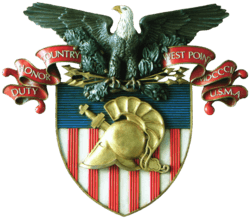Jonathan Williams (engineer)
| Jonathan Williams | |
|---|---|
 Colonel Jonathan Williams, Chief Engineer | |
| Born |
May 20, 1751 Boston, Massachusetts |
| Died |
May 16, 1815 (aged 63) Philadelphia, Pennsylvania |
| Allegiance | United States |
| Service/branch | Army |
| Years of service | 1801 - 1812 |
| Rank | Colonel |
| Unit | Corps of Engineers |
| Commands held |
Chief of Engineers Superintendent of the United States Military Academy |
Jonathan Williams (May 20, 1751 – May 16, 1815), American businessman, military figure, politician and writer. He became Chief of Engineers of the Army Corps of Engineers, was the first superintendent of United States Military Academy, and was elected to the Fourteenth United States Congress.
Biography
Williams was born in Boston, Massachusetts and attended Harvard University.
Williams, a grandnephew of Benjamin Franklin, spent most of the period from 1770 to 1785 in England and France, where he assisted Franklin with business affairs and served as a commercial agent for the U.S. Navy in Nantes. Back in the United States, he joined the American Philosophical Society in 1788 and published articles on scientific subjects.
President John Adams appointed Williams a major in the Corps of Artillerists and Engineers in February 1801. President Thomas Jefferson made him the Army's Inspector of Fortifications and assigned him to serve as the first superintendent of West Point in December 1801. The following year Jefferson also appointed him to concurrently command the separate Corps of Engineers established by Congress on March 16, 1802. He vacated (not resigned) his Superintendent position in 1803 but was reappointed in 1805.[1]
In 1802, the investor Richard Woodhull purchased 13 acres (53,000 m2) in north Brooklyn and named the area Williamsburgh (later changed to Williamsburg), after Williams, who surveyed the land.
From 1807 to 1811 Williams designed and completed construction of Castle Williams (the East Battery) and Castle Clinton (the West Battery) in New York Harbor. Castle Williams was the first casemated battery in the United States. He founded the U.S. Military Philosophical Society and gave it its motto, "Science in War is the Guarantee of Peace."
He resigned from the Army in July 1812 because the Secretary of War, William Eustis, refused to give him command of Castle Williams, a fortification that he designed and was named after him.[2] At that time, New York State placed him in charge of construction of fortifications for New York City. He eventually returned to Philadelphia and headed a group of volunteer engineers building fortifications around the city when he was elected to the Fourteenth United States Congress from that city in 1814. He died of gout in Philadelphia before the Congress assembled.
He was originally buried in Pine Street Cemetery between 4th and 5th Streets in Philadelphia and was re-interred in Laurel Hill Cemetery not far from his home, Mount Pleasant in Fairmount Park, in 1862.
References
- ↑ "Williams, Jonathan Mss.". Lilly Library Manuscript Collections. Indiana University. Retrieved 2009-04-06.
- ↑ "Jonathan Williams, 1751-1851". United States Military Academy. Retrieved 2009-04-06.
- This article contains public domain text from "Colonel Jonathan Williams". Portraits and Profiles of Chief Engineers. Retrieved 2009-04-06.
- Jonathan Williams at the Biographical Directory of the United States Congress
- The Political Graveyard
External links
| Military offices | ||
|---|---|---|
| Preceded by none |
Superintendent of the U.S. Military Academy 1801–1803 |
Succeeded by Decius Wadsworth |
| Preceded by Decius Wadsworth |
Superintendent of the U.S. Military Academy 1805–1812 |
Succeeded by Joseph Gardner Swift |
| Preceded by Henry Burbeck |
Chief of Engineers 1802–1803 1805–1812 |
Succeeded by Joseph Gardner Swift |
| United States House of Representatives | ||
| Preceded by Thomas Smith |
Member of the U.S. House of Representatives from Pennsylvania's 1st congressional district 1815 |
Succeeded by John Sergeant |
| ||||||||||||||||||||||||||||||||||
|
